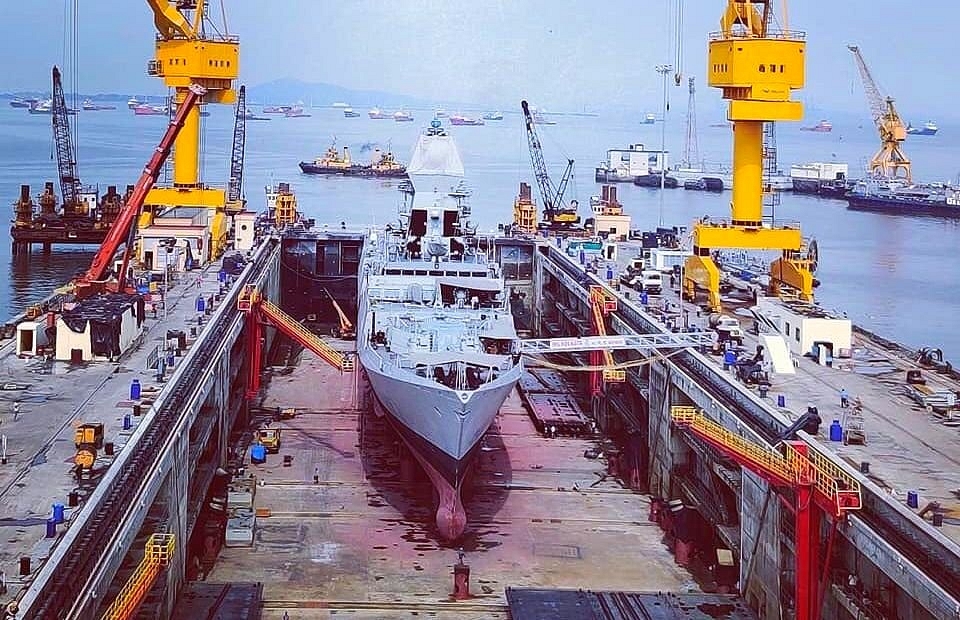News Brief
Explained: Navy’s New Dry Dock To Service Aircraft Carriers; How India Built This Engineering Marvel

New aircraft carrier dry dock at Mumbai (Source: @thakur_shivangi/Twitter)
Indian Navy is set to inaugurate its new aircraft carrier dry dock at Mumbai on 28 September.
India already had three British era dry docks but they don’t have the capacity to accommodate aircraft carrier ships like INS Vikramaditya. With the induction of the latter, a new dry dock with the enhanced capacity was required.
The construction was a mammoth task which took almost a decade’s time to complete. At 281 m long, 45 m wide and almost 17 m deep, the dry dock has a large size, and can accommodate two smaller vessels at the same time, apart from berthing the aircraft carrier. This is made possible by the three intermediate gates that can divide the dock across its length.
Costing about Rs 1,000 crore, the dry dock was built 300 m into the sea with only its head on land. First a coffer dam was built with 114 piles of steel and concrete to keep the water out, and construction was carried out on the sea bed for a 281 m long dock and the wharves on each of its sides.
Around 2.23 lakh tonnes of silt had to be removed from the site, enough to lay 90 football fields. The project required 8000 metric tonnes of steel and 5 metric tonnes of concrete, 1.5 times that used in Mumbai’s iconic Bandra-Worli sea link.
It is a modern dry-dock with high automation, and can be dewatered in less than three hours and filled back within just one and a half hour.
Utility
The ships need regular repair, refuelling and maintenance which cannot be carried out when they are sailing. Dry dock is essentially a berthing place where these works are carried out after dewatering the dock using high power water pumps, so that the submerged portions of the hull can be cleaned, inspected and repaired.
Milind Kulshreshtha notes the following steps involved in the process:
Special blocks for the ship to sit on are placed on the floor of the dock. These are designed as per the ship’s underwater profile. The ship is brought into accurate position over the blocks with the help of the tug boats and and caisson gates are closed. Then the dock water i drained gradually so that the ship is well-settled on the blocks.
Next, necessary underwater Hull maintenance and repairs and routines on underwater equipment like Sonars, sea valves, etc are carried out. No machinery is allowed to run on board and proper earthing arrangements are made.
Rust or defective paint from the ship side and old paint is removed through ‘blasting’ and once the bare steel is exposed, the entire vessel is cleaned and painted. The sea-water is used for cleaning cooling systems in the engine room and sea valves. Routine repairs are completed. Finally, the anti-fouling paint is used for underwater side to prevent marine growth.
Then alignment checks are carried out using various techniques and degaussing of the ship is done so as to reduce ship’s magnetic signature.
After all maintenance work is completed, the dock is gradually flooded back for a balanced rise of the ship. One the ship is completely off the blocks, the caisson gates are opened and the ship moved out using Tug boats.
Introducing ElectionsHQ + 50 Ground Reports Project
The 2024 elections might seem easy to guess, but there are some important questions that shouldn't be missed.
Do freebies still sway voters? Do people prioritise infrastructure when voting? How will Punjab vote?
The answers to these questions provide great insights into where we, as a country, are headed in the years to come.
Swarajya is starting a project with an aim to do 50 solid ground stories and a smart commentary service on WhatsApp, a one-of-a-kind. We'd love your support during this election season.
Click below to contribute.
Latest